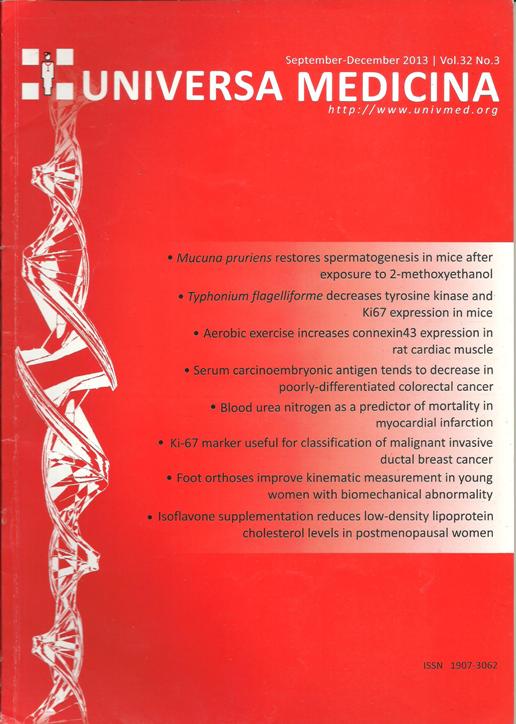Ki-67 marker useful for classification of malignant invasive ductal breast cancer
Main Article Content
Abstract
Breast cancer is an important health problem in the world. Uncontrolled cell proliferation represents a malignant characteristic of neoplasia such as breast cancer, and can be examined immunohistochemically by measuring the Ki-67 proliferative marker. The objective of this study was to determine the role of Ki-67 for classification of the degree of malignancy in women with invasive ductal breast cancer.
METHODS
A cross-sectional study was conducted on 20 women with invasive ductal breast cancer. The samples were immuno-histochemically tested for Ki-67 using anti-Ki-67 primary antibody. The Ki-67 proliferative index was determined by enumerating the proportion of Ki-67 positive nuclei among the total number of cells in ten areas observed at 400x magnification, using a 20% cut-off value to distinguish between low and high proliferative indices. Statistical analysis was by means of the chi-square test.
RESULTS
Seventy five persent of the high grade malignancies had a high Ki-67 proliferative index (>20%), while only 12.5% of the low grade malignancies had a high Ki-67 index (>20%). The difference in grade malignancy was statistically significant (p=0.022), whereas tumor size was not associated with a statistically significant difference in Ki-67 index (p=0.648).
CONCLUSION
The study showed that invasive ductal breast cancer with high Ki-67 index was significantly associated with high grade of malignacy. The high Ki-67 marker index can be used for classification of the grade of malignancy of invasive ductal breast cancer.
Article Details
Issue
Section
The journal allows the authors to hold the copyright without restrictions and allow the authors to retain publishing rights without restrictions.
How to Cite
References
Jemal A, Bray F, Center MM, Ferlay J, Ward E, Forman D. Cancer global statistic. CA Cancer J Clin 2011;61:69-90.
Direktorat Jendral Pelayanan Medik Departemen Kesehatan R.I. Badan Registrasi Kanker Perhimpunan Dokter Spesialis Patologi Indonesia, Yayasan Kanker Indonesia. Kanker di Indonesia tahun 1988, 1998, 2008: data histopatologik. Jakarta: Direktorat Jendral Pelayanan Medik Departemen Kesehatan R.I.;2009.
Allen DC. Histopathology reporting: guidelines for surgical cancer. 3rd ed. London: Springer; 2013.
Trihia H, Murray S, Price K, Gelbert RD, Golouh R, Goldhirsch A, et al. Ki-67 expression in breast carcinoma: its associations with grading systems, clinical parameters, and other prognostic factors – a surrogate marker? Cancer 2003;97:1321-31.
Keam B, Im SA, Lee KH, Han SW, Oh DY, Kim JH, et al. Ki-67 can be used for further classification of triple negative breast cancer into two subtypes with different response and prognosis. Breast Cancer Res 2011;13:R22.
Jonat W, Arnold N. Is the Ki-67 labelling index ready for clinical use? Ann Oncol 2011;22:500-2. doi:10.1093/annonc/mdq732.
Urruticoechea A, Smith IE, Dowsett M. Proliferation marker Ki-67 in early breast cancer. J Clin Oncol 2005;23:7212-20.
Barnard NJ, Hall PA, Lemoine NR, Kadar N. Proliferative index in breast carcinoma determined in situ by Ki-67 immunostaining and its relationship to clinical and pathological variables. J Pathol 2005. doi: 10.1002/path. 1711520407.
Goldhirsch A, Ingle JN, Gelber RD, Coates AS, Thürlimann B, Senn HJ. Thresholds for therapies: highlights of the St Gallen International Expert Consensus on the primary therapy of early breast cancer 2009. Annal Oncol 2009;20:1319-29.
De Azambuja E, Cardoso F, de Castro Jr G, Colozza M, Mano MS, Durberq V, et al. Ki-67 as prognostic marker in early breast cancer: a meta-analysis of published studies involving 12,155 patients. Br J Cancer 2007;96:1504-13.
Yerushalmi R, Woods R, Ravdin PM, Hayes MM, Gelmon KA. Ki-67 in breast cancer: prognostic and predictive potential. Lancet Oncol 2010;11: 174-83.
Bonnefoi H, Underhill C, Inggo R, Cameron D. Predictive signatures for chemotherapy sensitivity in breast cancer: are they ready for use in clinic? Eur J Cancer 2009;45:1733-43.
Colloza M, Sidoni A, Piccart-Gebhart M. Value of Ki-67 in breast cancer: the debate is still open. Lancet Oncol 2010;11:414-5.
Nishimura R, Osaka T, Okumura Y, Hayashi M, Toyozumi Y, Arima N. Ki-67 as a prognostic marker according to breast cancer subtype and a predictor of recurrence time in primary breast cancer. Exp Ther Med 2010;1:747-54.
Tavassoli FA, Devilee P, editors. World Health Organization classification of tumours, pathology and genetics of tumours of the breast and female genital organs. Lyon: IARC;2003.
Wiesner FC, Magener A, Fasching PA, Wesse J, Bani MR, Rauh C, et al. Ki-67 as a prognostic molecular marker in routine clinical use in breast cancer patients. Breast 2009;18:135-41.
Nishimura R, Osaka T, Okumura Y, Hayashi M, Arima N. Clinical significance of Ki-67 in neoadjuvant chemotherapy for primary breast cancer as a predictor for chemosensitivity and for prognosis. Breast Cancer 2010;17:269-75.
Patil AV, Singhai R, Bhamre RS, Patil VW. Ki-67 biomarker in breast cancer of Indian woman. N Am J Med Sci 2011;3:119-28.
Loly D. Hubungan imunoekspresi Ki-67 dengan beberapa parameter prognostic histopatologik karsinoma payudara invasif di tiga Laboratorium Patologi Anatomi Sumatera Barat (thesis). Padang: F.K. Unandalas;2011.
Zabaglo L, Salter J, Anderson H, Quinn E, Hills M, Detre S, et al. Comparative validation of the SP6 antibody to Ki-67 in breast cancer. J Clin Pathol 2010;63:800-4.


